Automated Locating Mining-Induced Microseismicity without Arrival Picking by Weighted STA/LTA Traces Stacking
Abstract
1. Introduction
2. Materials and Methods
2.1. Waveform Preprocessing
- Normalized absolute amplitude. Waveform normalization eliminates the effects of attenuation due to geometric expansion and avoids station main-stack near the source. Take the absolute value of the waveform to avoid the peaks and valleys offsetting each other. The equation is as follows:where is the original microseismic record, is the normalized absolute amplitude.
- Normalized waveform envelope:where is the normalized waveform envelope. is the Hilbert transform.
- Normalized STA/LTA traces. STA/LTA is a classic method of arrival picking. There are many calculation methods for its characteristic function. We use an improved version of the equation proposed by Allen in 1978 [25]:where is the difference of . is the length of the microseismic record. is a weighting constant that varies with sample rate and station noise characteristics. and are the traces of short and long windows. is the ratio of to . and are the lengths of short and long windows, respectively. is the STA/LTA trace.
2.2. Evaluation of Waveform Quality
- Calculate the SNR by the following equation:where and are the length of the noise segment and the signal segment, respectively. and are the average energy of noise and signal, respectively. is the signal-to-noise ratio.
- 2.
- The equation for calculating ADS can be written as:
- 3.
- We calculate the ADJ by:
2.3. Solving the Stacking Function Based on WDE
3. Blasting Experiment Verification
4. Application and Discussion
- Based on the arrival-based method, the spatial location error of blasting event A is 21.83 m (The first experiment using R1, R2, R4–R8) < 27.79 m (the second experiment using R1, R2, R5–R8) <32.39 m (Using R1–R8). The reason is as follows: As seen from Table 5, the R3 stacking weight is 0.53, and the R4 stacking weight is 0.61. The R3 waveform quality is the worst, and the picking error is large, which affects the location accuracy.
- The spatial location error of the blasting event A based on the traditional stack-based method is 5.57 m (Uncontaminated) <11.75 m (the first experiment) <21.61 m (the second experiment).
- The spatial location error of the proposed method for blasting event A is 0.63 m (Uncontaminated) <7.66 m (the first experiment) <15.85 m (the second experiment).
- In summary, the following conclusions can be drawn: 1. In the case of good waveform quality, the location accuracy based on the stack-based method, and the arrival-based method may not be much different. However, when the waveform quality is poor, the arrival-based method is likely to cause a large location error due to inaccurate arrival picking, while the stack-based method is better. 2. The proposed method has higher location accuracy than the traditional stack-based method. 3. The more effective the waveforms, the more accurate the location results of the stack-based method.
5. Conclusions
Author Contributions
Funding
Conflicts of Interest
Appendix A
Appendix A.1. Waveforms and STA/LTA Traces of Blasting Event A

Appendix A.2. Waveforms and STA/LTA Traces of Blasting Event B

Appendix A.3. Comparison of Location of Blasting Event A

Appendix A.4. Comparison of Location of Blasting Event B

References
- Ghosh, G.K.; Sivakumar, C. Application of underground microseismic monitoring for ground failure and secure longwall coal mining operation: A case study in an Indian mine. J. Appl. Geophys. 2018, 150, 21–39. [Google Scholar] [CrossRef]
- Li, Y.; Yang, T.; Liu, H.; Hou, X.; Wang, H. Effect of mining rate on the working face with high-intensity mining based on microseismic monitoring: A case study. J. Geophys. Eng. 2017, 14, 350–358. [Google Scholar] [CrossRef]
- Li, Y.; Yang, T.H.; Liu, H.L.; Wang, H.; Hou, X.G.; Zhang, P.H.; Wang, P.T. Real-time microseismic monitoring and its characteristic analysis in working face with high-intensity mining. J. Appl. Geophys. 2016, 132, 152–163. [Google Scholar] [CrossRef]
- Kinscher, J.; Bernard, P.; Contrucci, I.; Mangeney, A.; Piguet, J.P.; Bigarre, P. Location of microseismic swarms induced by salt solution mining. Geophys. J. Int. 2015, 200, 337–362. [Google Scholar] [CrossRef]
- Peng, P.; Wang, L. Targeted location of microseismic events based on a 3D heterogeneous velocity model in underground mining. PLoS ONE 2019, 14, e0212881. [Google Scholar] [CrossRef]
- Viana, Y.; Young, R.J.; Sousa-Lima, R.S.; Duarte, M.H. Mining noise affects Rufous-Collared Sparrow (Zonothichia capensis) vocalizations. J. Acoust. Soc. Am. 2017, 141, 3942. [Google Scholar] [CrossRef]
- Plenkers, K.; Ritter, J.R.R.; Schindler, M. Low signal-to-noise event detection based on waveform stacking and cross-correlation: Application to a stimulation experiment. J. Seismol. 2013, 17, 27–49. [Google Scholar] [CrossRef]
- Geiger, L. Probability method for the determination of earthquake epicenters from the arrival time only (translated from Geiger’s 1910 German article). Bull. St. Louis Univ. 1921, 8, 56–71. [Google Scholar]
- Lee, W.H.K.; Lahr, J.C.; Valdes, C.M. The HYPO71 earthquake location program. Int. Geophys. 2003, 81, 1641–1642. [Google Scholar]
- Xu, S.; Liu, J.; Xu, S.; Wei, J.; Huang, W.; Dong, L. Experimental studies on pillar failure characteristics based on acoustic emission location technique. Trans. Nonferrous Met. Soc. China 2012, 22, 2792–2798. [Google Scholar] [CrossRef]
- Waldhauser, F.; Ellsworth, W. A Double-Difference Earthquake Location Algorithm: Method and Application to the Northern Hayward Fault, California. Bull. Seismol. Soc. Am. 2000, 90, 1353–1368. [Google Scholar] [CrossRef]
- Zhang, H. Double-Difference Tomography: The Method and Its Application to the Hayward Fault, California. Bull. Seismol. Soc. Am. 2003, 93, 1875–1889. [Google Scholar] [CrossRef]
- Cheng, J.; Song, G.; Sun, X.; Wen, L.; Li, F. Research Developments and Prospects on Microseismic Source Location in Mines. Engineering 2018, 4, 653–660. [Google Scholar] [CrossRef]
- Kao, H.; Shan, S.J. The Source-Scanning Algorithm: Mapping the distribution of seismic sources in time and space. Geophys. J. Int. 2004, 157, 589–594. [Google Scholar] [CrossRef]
- Kao, H.; Shan, S.J. Rapid identification of earthquake rupture plane using Source-Scanning Algorithm. Geophys. J. Int. 2007, 168, 1011–1020. [Google Scholar] [CrossRef]
- Kan, C.W.; Kao, H.; Ou, G.B.; Chen, R.Y.; Chang, C.H. Delineating the rupture planes of an earthquake doublet using Source-Scanning Algorithm: Application to the 2005 March 3 Ilan Doublet, northeast Taiwan. Geophys. J. Int. 2010, 182, 956–966. [Google Scholar] [CrossRef]
- Yu, Y.; Liang, C.; Wu, F.; Wang, X.; Yu, G.; Chu, F. On the accuracy and efficiency of the joint source scanning algorithm for hydraulic fracturing monitoring. Geophysics 2018, 83, KS77–KS85. [Google Scholar] [CrossRef]
- Liao, Y.C.; Kao, H.; Rosenberger, A.; Hsu, S.K.; Huang, B.S. Delineating complex spatiotemporal distribution of earthquake aftershocks: An improved Source-Scanning Algorithm. Geophys. J. Int. 2012, 189, 1753–1770. [Google Scholar] [CrossRef]
- Gharti, H.N.; Oye, V.; Roth, M.; Kühn, D. Automated microearthquake location using envelope stacking and robust global optimization. Geophysics 2010, 75, MA27–MA46. [Google Scholar] [CrossRef]
- Zeng, X.; Zhang, H.; Zhang, X.; Wang, H.; Zhang, Y.; Liu, Q. Surface Microseismic Monitoring of Hydraulic Fracturing of a Shale-Gas Reservoir Using Short-Period and Broadband Seismic Sensors. Seismol. Res. Lett. 2014, 85, 668–677. [Google Scholar] [CrossRef]
- Langet, N.; Maggi, A.; Michelini, A.; Brenguier, F. Continuous Kurtosis-Based Migration for Seismic Event Detection and Location, with Application to Piton de la Fournaise Volcano, La Reunion. Bull. Seismol. Soc. Am. 2014, 104, 229–246. [Google Scholar] [CrossRef]
- Grigoli, F.; Cesca, S.; Vassallo, M.; Dahm, T. Automated Seismic Event Location by Travel-Time Stacking: An Application to Mining Induced Seismicity. Seismol. Res. Lett. 2013, 84, 666–677. [Google Scholar] [CrossRef]
- Drew, J.; White, R.S.; Tilmann, F.; Tarasewicz, J. Coalescence microseismic mapping. Geophys. J. Int. 2013, 195, 1773–1785. [Google Scholar] [CrossRef]
- Cesca, S.; Grigoli, F. Full waveform seismological advances for microseismic monitoring. Adv. Geophys. 2015, 56, 169–228. [Google Scholar]
- Allen, R. Automatic phase pickers: Their present use and future prospects. Bull. Seismol. Soc. Am. 1982, 72, 225–242. [Google Scholar]
- Peng, P.; Wang, L. 3DMRT: A Computer Package for 3D Model-Based Seismic Wave Propagation. Seismol. Res. Lett. 2019, 90, 2039–2045. [Google Scholar] [CrossRef]
- Kummerow, J. Using the value of the crosscorrelation coefficient to locate microseismic events. Geophysics 2010, 75, MA47–MA52. [Google Scholar] [CrossRef]
- Civicioglu, P.; Besdok, E.; Gunen, M.A.; Atasever, U.H. Weighted differential evolution algorithm for numerical function optimization: A comparative study with cuckoo search, artificial bee colony, adaptive differential evolution, and backtracking search optimization algorithms. Neural Comput. Appl. 2020, 32, 3923–3937. [Google Scholar] [CrossRef]


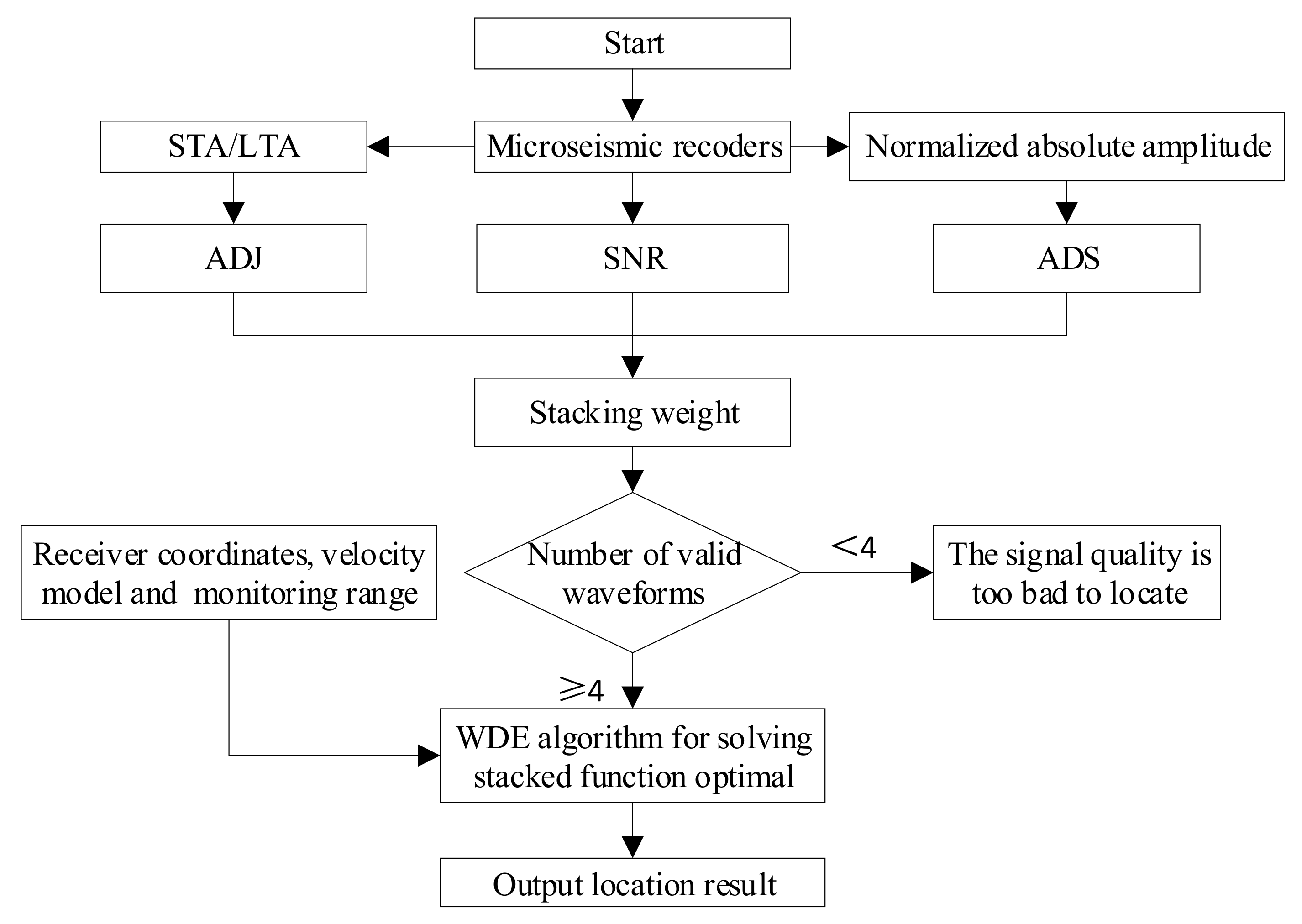
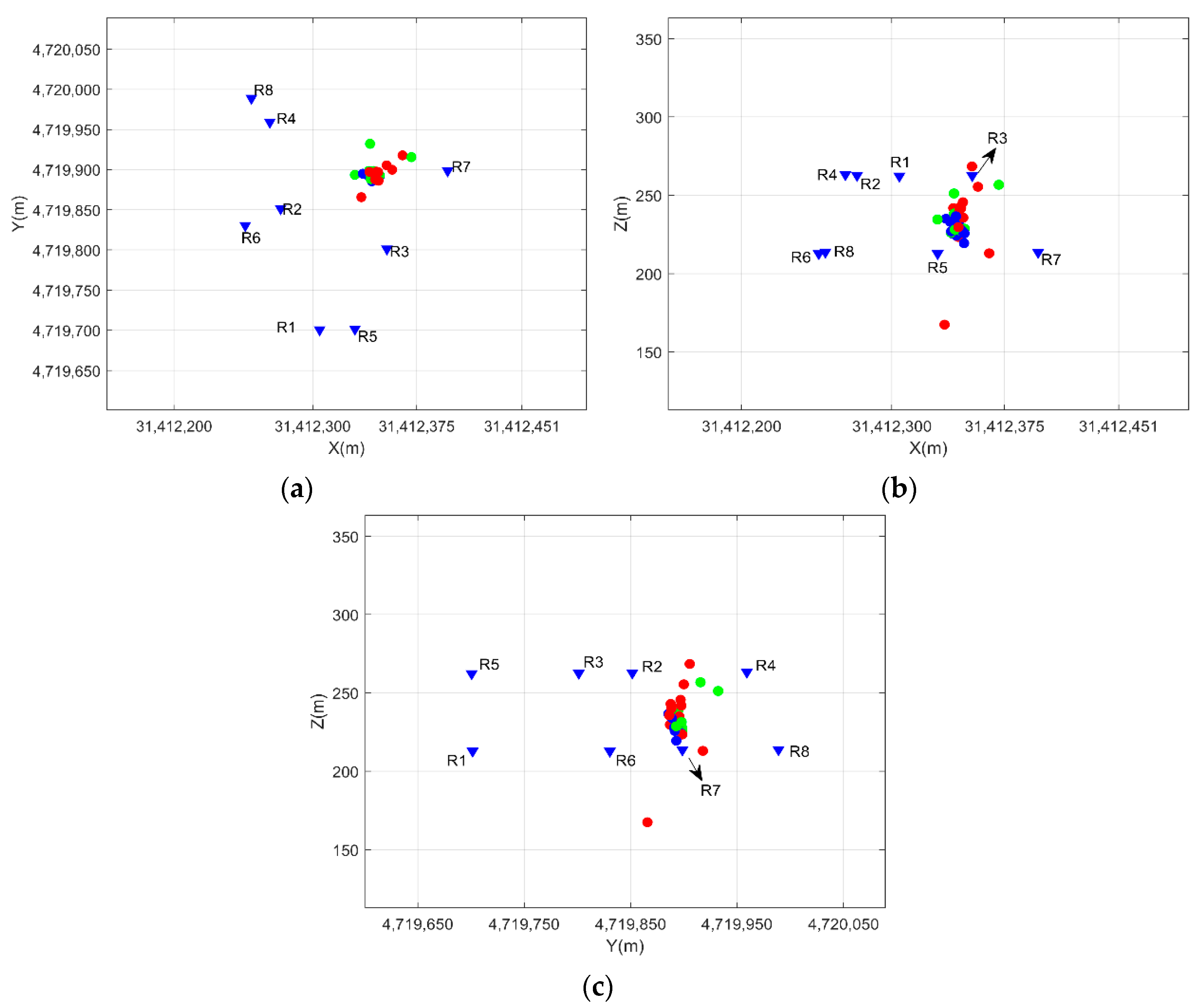
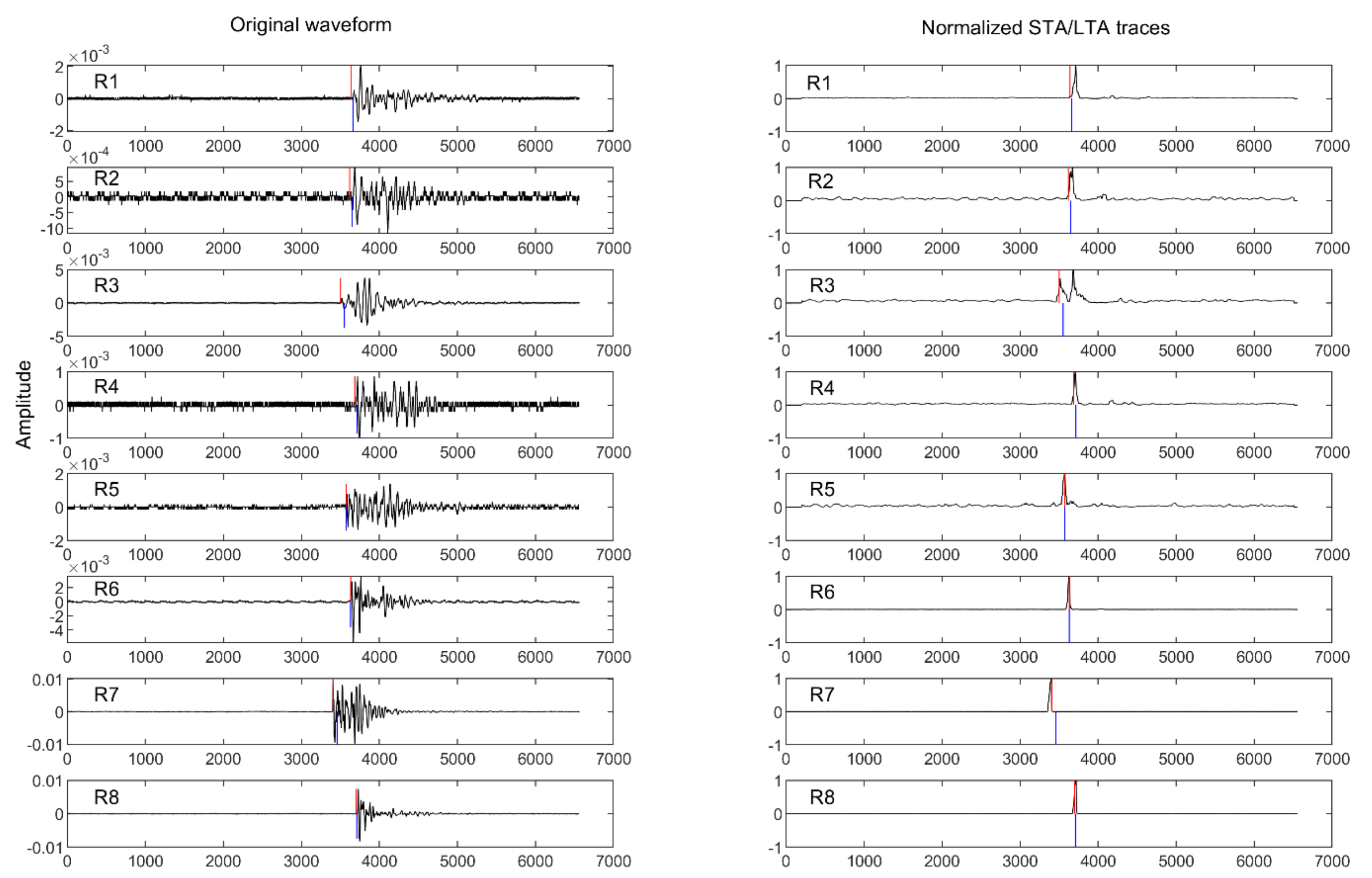
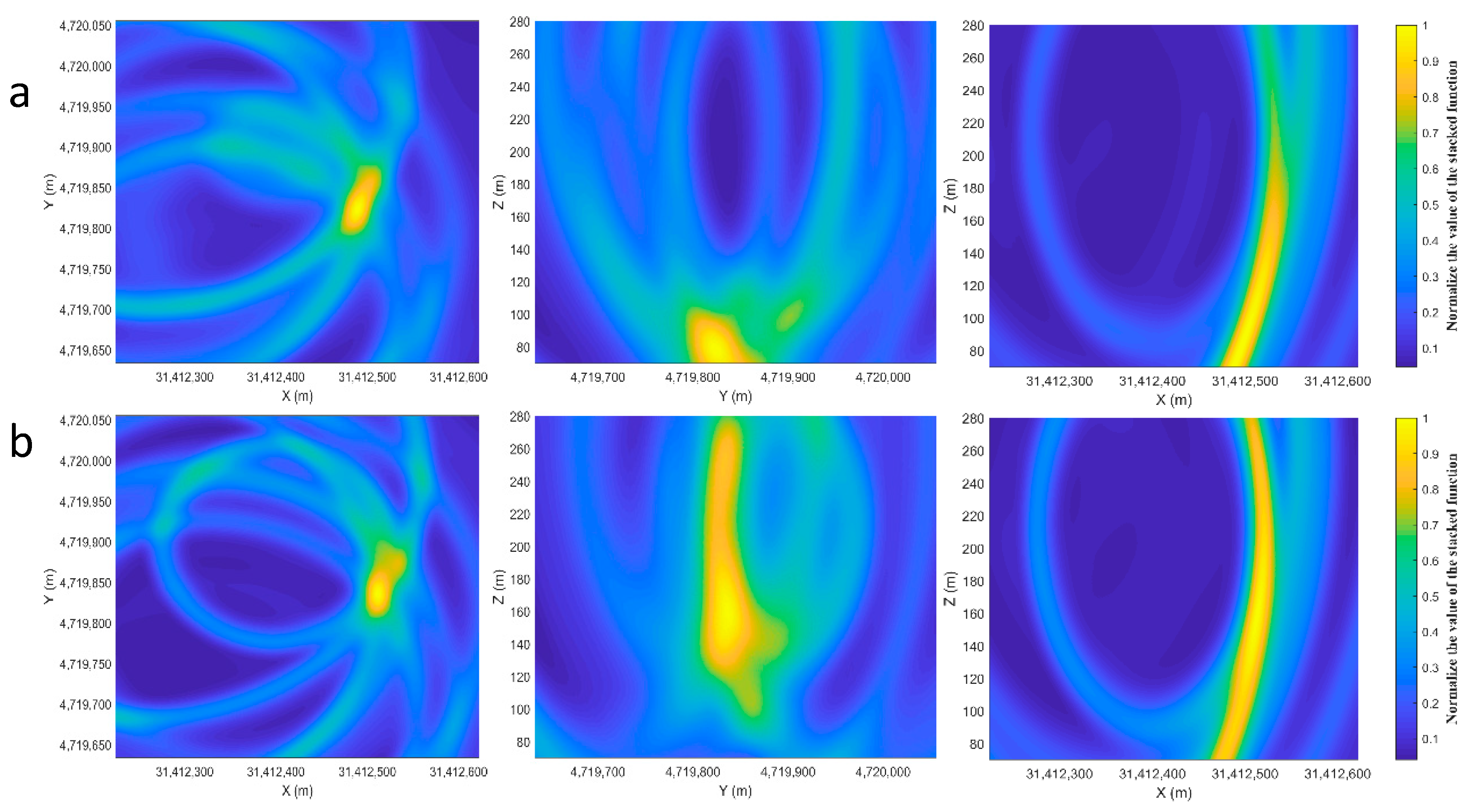

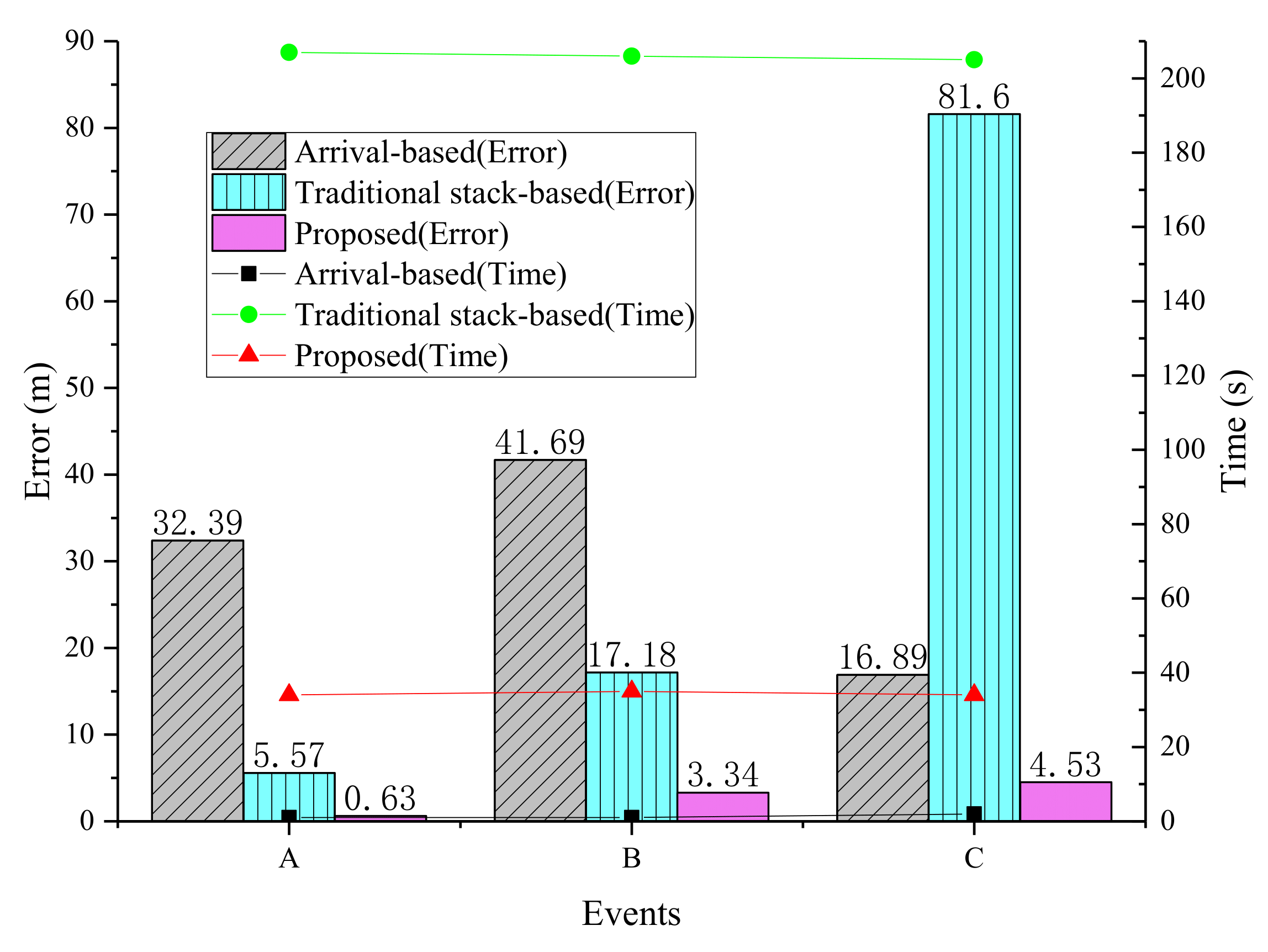

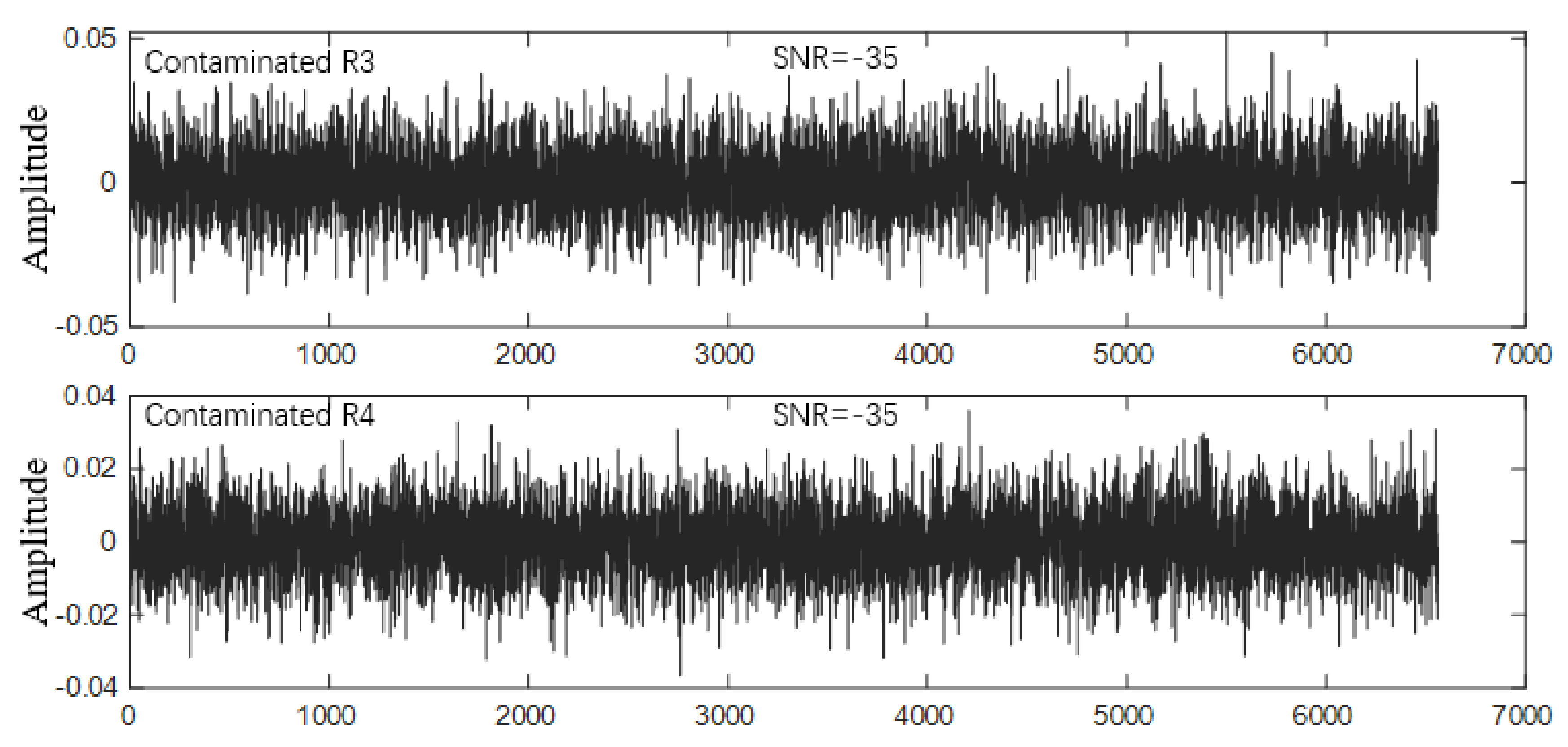
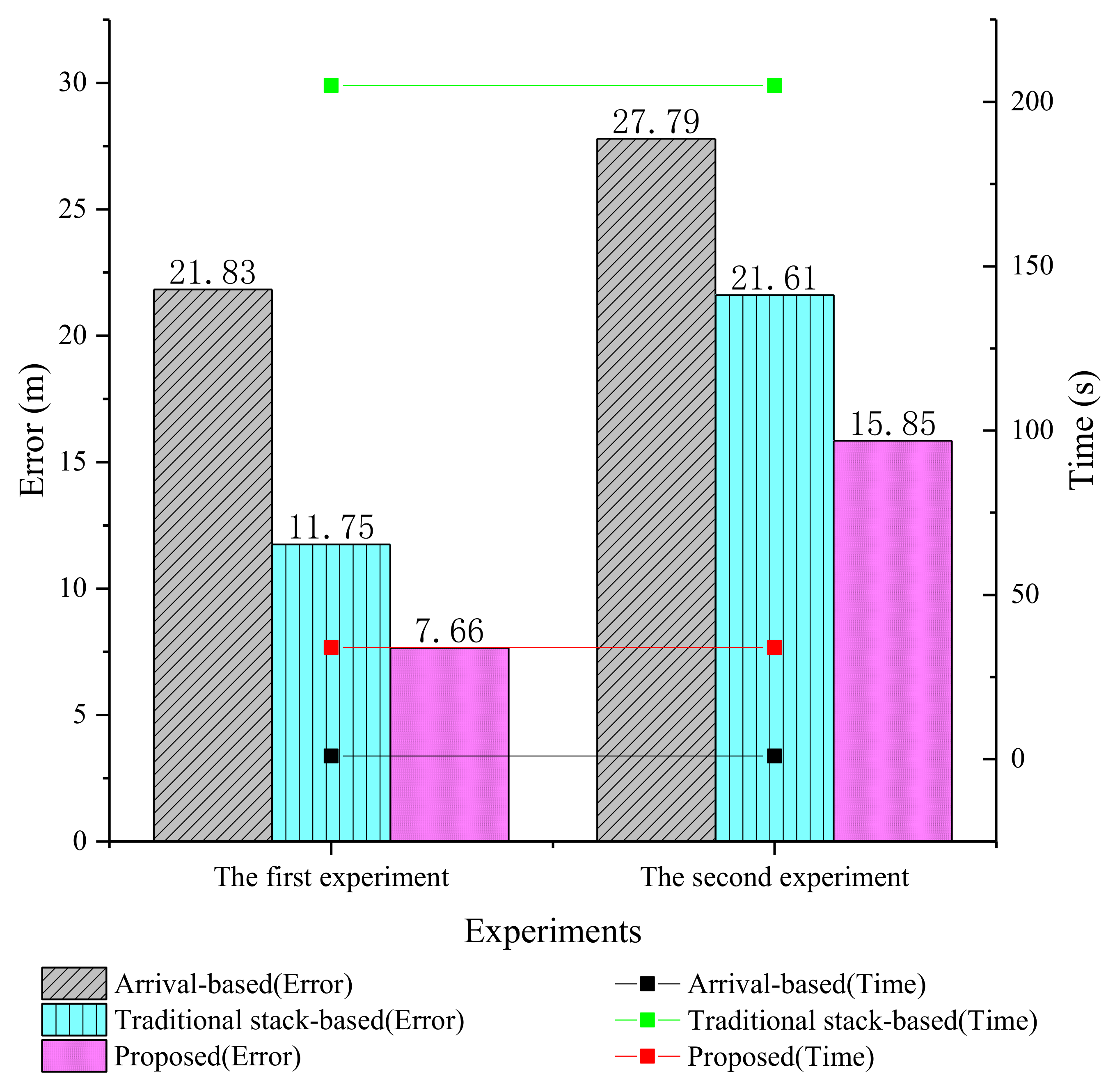
| Waveform | SNR | ADS | ADJ | W |
|---|---|---|---|---|
| a | 0.055 | 0.808 | 0.698 | 0 |
| b | 4.58 | 0.881 | 0.778 | 0.131 |
| c | 3.26 | 0.909 | 0.922 | 0.217 |
| d | 43.55 | 0.989 | 0.996 | 0.926 |
| X (m) | Y (m) | Z (m) | |
|---|---|---|---|
| R1 | 31,412,305.05 | 4,719,700.62 | 262.33 |
| R2 | 31,412,276.88 | 4,719,851.50 | 262.81 |
| R3 | 31,412,353.56 | 4,719,801.24 | 262.64 |
| R4 | 31,412,269.13 | 4,719,959.10 | 263.30 |
| R5 | 31,412,330.52 | 4,719,701.52 | 212.85 |
| R6 | 31,412,251.40 | 4,719,830.41 | 212.82 |
| R7 | 31,412,397.38 | 4,719,898.55 | 213.62 |
| R8 | 31,412,255.82 | 4,719,988.82 | 213.78 |
| Event | Method | X (m) | Y (m) | Z (m) | Error (m) | Time (s) |
|---|---|---|---|---|---|---|
| A | True | 31,412,542.00 | 4,719,739.00 | 72.00 | - | - |
| Arrival-based | 31,412,513.13 | 4,719,744.23 | 85.72 | 32.39 | 1 | |
| Stack-based | 31,412,536.78 | 4,719,738.21 | 70.24 | 5.57 | 207 | |
| Proposed | 31,412,542.25 | 4,719,739.09 | 71.43 | 0.63 | 34 | |
| B | True | 31,412,518.00 | 4,719,840.00 | 162.00 | - | - |
| Arrival-based | 31,412,477.41 | 4,719,841.09 | 171.43 | 41.69 | 1 | |
| Stack-based | 31,412,518.54 | 4,719,834.69 | 145.67 | 17.18 | 206 | |
| Proposed | 31,412,517.75 | 4,719,841.88 | 164.75 | 3.34 | 35 | |
| C | True | 31,412,503.00 | 4,719,835.00 | 153.00 | - | - |
| Arrival-based | 31,412,486.34 | 4,719,837.78 | 152.80 | 16.89 | 2 | |
| Stack-based | 31,412,493.10 | 4,719,823.78 | 72.79 | 81.60 | 205 | |
| Proposed | 31,412,506.91 | 4,719,836.65 | 154.60 | 4.53 | 34 |
| Blasting | Receiver | SNR | ADS | ADJ | WW | |||
|---|---|---|---|---|---|---|---|---|
| A | R1 | 26.83 | 0.60 | 0.99 | 1.00 | 0.95 | 1.00 | 0.77 |
| R2 | 15.86 | 0.35 | 0.98 | 1.00 | 0.95 | 1.00 | 0.59 | |
| R3 | 17.45 | 0.39 | 0.91 | 0.83 | 0.93 | 0.83 | 0.53 | |
| R4 | 19.08 | 0.42 | 0.96 | 1.00 | 0.93 | 1.00 | 0.61 | |
| R5 | 46.18 | 1.00 | 1.00 | 1.00 | 0.98 | 1.00 | 1.00 | |
| R6 | 27.23 | 0.61 | 0.99 | 1.00 | 0.97 | 1.00 | 0.78 | |
| R7 | 34.50 | 0.77 | 0.99 | 1.00 | 0.97 | 1.00 | 0.88 | |
| R8 | 39.14 | 0.87 | 1.00 | 1.00 | 0.98 | 1.00 | 0.93 | |
| B | R1 | 8.37 | 0.19 | 0.94 | 0.97 | 0.90 | 0.97 | 0.34 |
| R2 | 9.08 | 0.20 | 0.93 | 0.90 | 0.92 | 0.90 | 0.38 | |
| R3 | 20.51 | 0.46 | 0.90 | 0.81 | 0.92 | 0.81 | 0.55 | |
| R4 | 8.53 | 0.19 | 0.81 | 0.45 | 0.83 | 0.45 | 0.12 | |
| R5 | 19.63 | 0.44 | 0.96 | 1.00 | 0.90 | 1.00 | 0.55 | |
| R6 | 20.13 | 0.45 | 0.99 | 1.00 | 0.95 | 1.00 | 0.67 | |
| R7 | 47.34 | 1.00 | 0.99 | 1.00 | 0.98 | 1.00 | 1.00 | |
| R8 | 34.54 | 0.77 | 0.99 | 1.00 | 0.98 | 1.00 | 0.88 | |
| C | R1 | 15.36 | 0.34 | 0.97 | 1.00 | 0.94 | 0.96 | 0.57 |
| R2 | 10.60 | 0.24 | 0.94 | 0.95 | 0.92 | 0.80 | 0.42 | |
| R3 | 31.21 | 0.69 | 0.92 | 0.90 | 0.95 | 1.00 | 0.79 | |
| R4 | 10.65 | 0.24 | 0.96 | 1.00 | 0.90 | 0.67 | 0.40 | |
| R5 | 22.06 | 0.49 | 0.95 | 1.00 | 0.93 | 0.84 | 0.64 | |
| R6 | 27.17 | 0.60 | 0.99 | 1.00 | 0.97 | 1.00 | 0.78 | |
| R7 | 48.02 | 1.00 | 0.99 | 1.00 | 0.96 | 1.00 | 1.00 | |
| R8 | 34.70 | 0.77 | 0.99 | 1.00 | 0.98 | 1.00 | 0.88 |
| - | Proposed | Stack-Based | Arrival-Based | |
|---|---|---|---|---|
| The First Experiment | X (m) | 31,412,549 | 31,412,552.5 | 31,412,522.9 |
| Y (m) | 4,719,740 | 4,719,738.75 | 4,719,738.9 | |
| Z (m) | 74.06 | 77.37 | 82.63 | |
| Error (m) | 7.66 | 11.75 | 21.83 | |
| Time (s) | 34 | 205 | 1 | |
| The Second Experiment | X (m) | 31,412,548 | 31,412,542.8 | 31,412,564.5 |
| Y (m) | 4,719,744 | 4,719,745.98 | 4,719,737.38 | |
| Z (m) | 85.92 | 92.44 | 88.28 | |
| Error (m) | 15.85 | 21.61 | 27.79 | |
| Time (s) | 34 | 205 | 1 | |
© 2020 by the authors. Licensee MDPI, Basel, Switzerland. This article is an open access article distributed under the terms and conditions of the Creative Commons Attribution (CC BY) license (http://creativecommons.org/licenses/by/4.0/).
Share and Cite
Jiang, Y.; Peng, P.; Wang, L.; He, Z. Automated Locating Mining-Induced Microseismicity without Arrival Picking by Weighted STA/LTA Traces Stacking. Sustainability 2020, 12, 3665. https://doi.org/10.3390/su12093665
Jiang Y, Peng P, Wang L, He Z. Automated Locating Mining-Induced Microseismicity without Arrival Picking by Weighted STA/LTA Traces Stacking. Sustainability. 2020; 12(9):3665. https://doi.org/10.3390/su12093665
Chicago/Turabian StyleJiang, Yuanjian, Pingan Peng, Liguan Wang, and Zhengxiang He. 2020. "Automated Locating Mining-Induced Microseismicity without Arrival Picking by Weighted STA/LTA Traces Stacking" Sustainability 12, no. 9: 3665. https://doi.org/10.3390/su12093665
APA StyleJiang, Y., Peng, P., Wang, L., & He, Z. (2020). Automated Locating Mining-Induced Microseismicity without Arrival Picking by Weighted STA/LTA Traces Stacking. Sustainability, 12(9), 3665. https://doi.org/10.3390/su12093665








